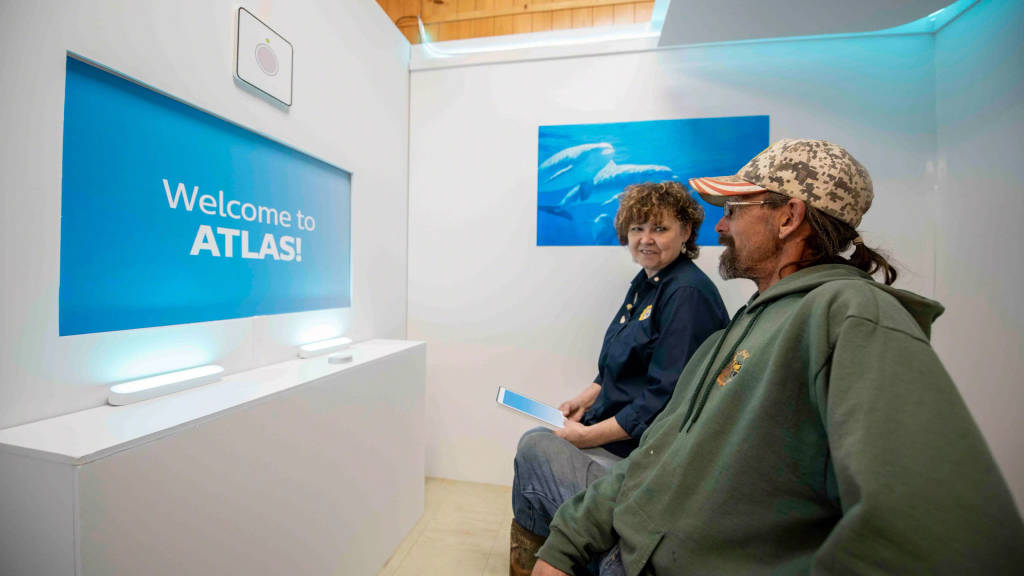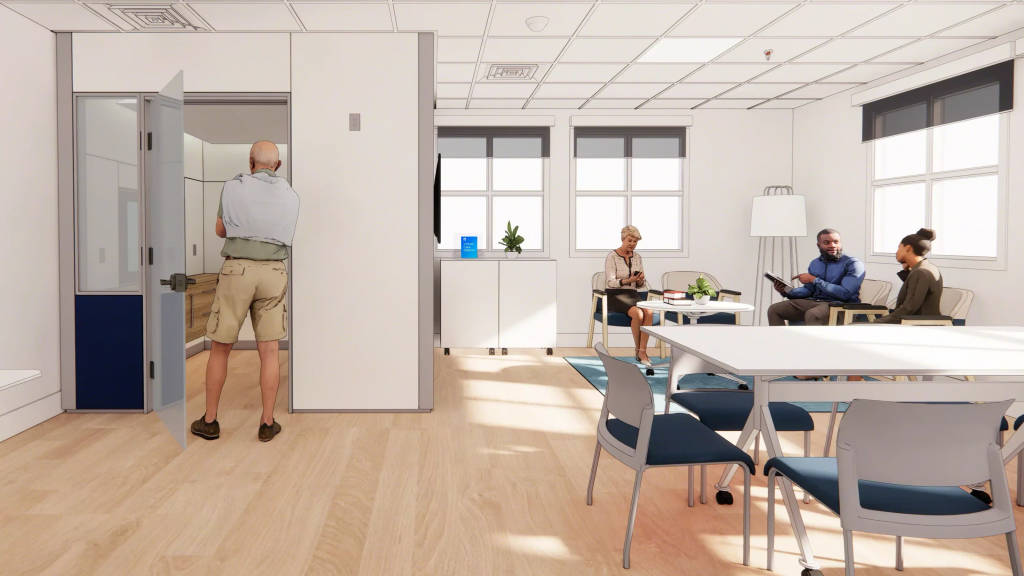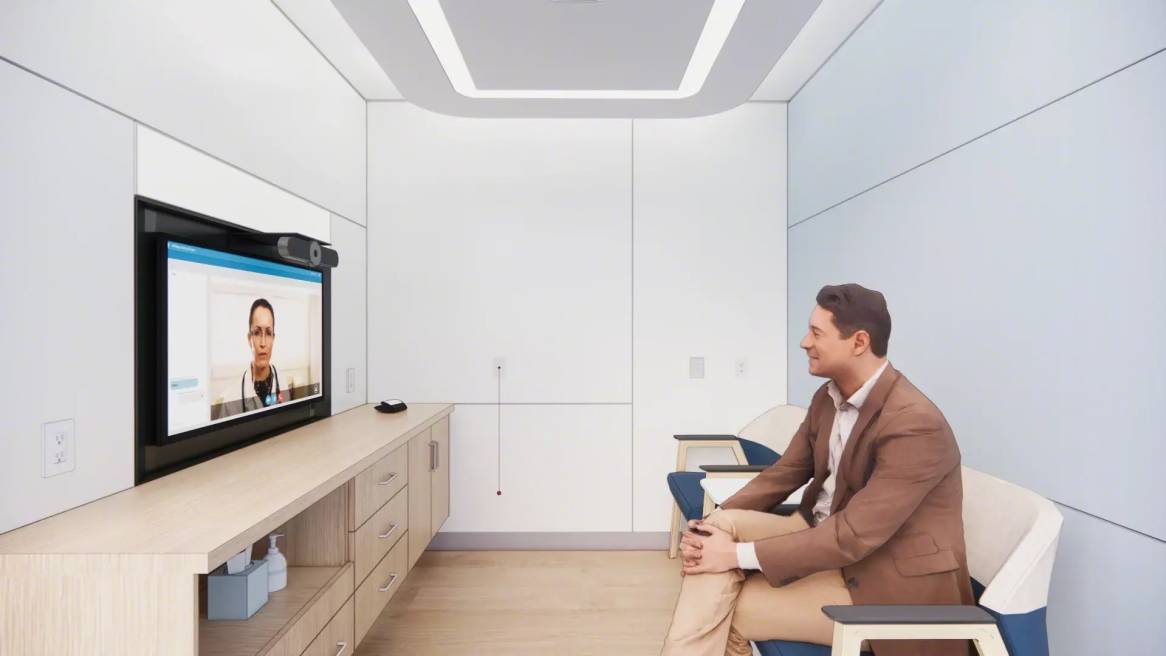Philips and Steelcase Team Up for Telehealth
A collaboration between global leaders in healthcare technologies and furniture leads to innovative care solutions for U.S. veterans.
360 recently sat down with two executives from Philips, a global leader in healthcare technologies, to talk about the ATLAS Virtual Care Station, a new product concept that leverages the company’s clinical and technological expertise to provide telehealth access to United States veterans in rural areas. Early in the development process, Philips invited Steelcase Health to help develop this breakthrough solution.
Nathan Naylor is Philips’ vice president of Veterans Healthcare and Sean Hughes is head of design consulting.
360: What makes the ATLAS Virtual Care Station so special and groundbreaking?
Nathan Naylor: ATLAS is a Veterans Administration program. The name stands for Accessing Telehealth through Local Area Stations. The VA came to us with a challenge. They wanted to provide more points of access to VA healthcare for veterans who don’t live near big cities, and they wanted to solve that problem with telehealth care stations in the Veterans of Foreign Wars (VFW) and American Legion halls that exist in most small communities. The VFW and American Legion also saw this as a strategy to keep their posts relevant by bringing something more into the community.
Our team pledged to design a solution with input from veterans and then donate our prototypes to 10 communities. We knew the solution shouldn’t be just a laptop with a webcam set up somewhere in an open room. The concept developed was for a clinical-grade enclosure, a medically appropriate room within a room where veterans can have privacy to talk with their doctor. We wanted to create a well-illuminated space with resilient internet and perfect acoustics for things like a hearing exam. The military term is a Forward Operating Base (FOB)– a secure place of comfort where you’ve got the stuff you need, and you know you’re not forgotten.
ATLAS is making it much easier for veterans who live in rural areas to have access to VA healthcare. It gets rid of obstacles like long driving times or limited broadband access at home. It lets them stay in touch with their VA doctor without a lot of hassles.
The VA is an awesome fit for Philips to prove new technologies and solutions. Inside our company, people are really excited about it. They want to be part of ATLAS because it’s doing what’s right for veterans.

360: Why did Philips invite Steelcase to be involved?
Sean Hughes: VFW and American Legion posts weren’t designed for medical appointments and there is a massive amount of variability among them. We realized early on that the fabric of the building was going to be a big problem for us. We have all the right technologies in the Philips portfolio, but the built environment is not in our skillset. That’s where we found a really good friend in Steelcase. We’re both companies with credible design that focuses on the user, we are steeped in innovation at the core, and we both also have a genuine willingness to do a good job and do well by our communities. There was a real meeting of the minds for this project. Through joint curiosity, we decided to go on this journey of discovery together.
360: How did you approach the design process?
SH: It was a design challenge on many levels, with a lot of unknowns. Initially we spent three days onsite to understand the veterans’ issues and explore how telehealth might manifest itself in their communities.
Next, we built a cardboard and foam mockup. We brought in VA care providers and actually ran appointments with a hole cut in the cardboard to simulate a screen with the clinician outside dialing in. In essence, we set up an opportunity to playact healthcare. The whole thing was an experiment, and we weren’t sure how the veterans would react. We started those three days with them sitting in chairs with their crossed arms and skeptical looks. But we decided to push forward – if we’re going to do this, let’s take all the principles we know about best practices in user-centered design and make it a design-led process. And they really got into it. There was tons of excitement, people wanted to play with the prototypes and you could see the wheels turning in their heads.
Those simulations gave us invaluable feedback from both the users and the VA doctors about their requirements for this to be successful. It’s really the power of creation, when you ask the user to participate, and they do it in earnest.
NN: We also had a real gift in being able to work with a group of caregivers from the Elizabeth Dole Foundation. They’ve been advocates for military caregivers for many years and they sent some people to join our team at three co-creation sessions. They gave us a lot of really interesting input about what other makers in the kiosk scene have missed the boat on.

360: What did you learn from the mockups and simulations?
SH: Very often, it was simple things we might have otherwise overlooked. For instance, going into it we thought the encounters would be one-on-one, but it became clear early on that we needed to design the space for two people because a lot of veterans would attend these appointments with somebody else. And we needed two entrances because some veterans didn’t want to be seen going in for a healthcare appointment. We needed to cover all the ADA compliance requirements, including access for motorized wheelchairs and service dogs. Other things such as visual privacy, acoustic privacy, hygiene and ergonomics also quickly became top of mind for us from a technology and user experience perspective.
NN: Another thing we picked up on was claustrophobia and the importance of the placement of the door. Many veterans always sit with their back to a wall so they can see their exits. They’ve lived in combat situations and that training never goes away.
360: Tell me about the solution you developed.
SH: Our friends at Steelcase were already familiar with the architecture problems we faced going in – different height ceilings, different ceiling properties, buildings of highly variable dimensions, walls not being straight. Because there is no standard floorplate among the ATLAS sites, we came up with three different configurations – a pod with a lid, a pod that extends to the ceiling and a wall liner that takes advantage of the room you already have. The Steelcase V.I.A. wall system the team recommended is a really robust product that met the requirements for acoustics and flexibility.
We married solutions from the Steelcase portfolio with the Philips innovation of a tunable ambient environment, where lighting technologies help people relax before the appointment begins and then brighten for the exam so the clinician can assess the patient with lighting that greatly improves the performance of the environment. The result is a radical shift in the telehealth experience for both patients and clinicians.
And, of course, a big priority was ease of use and simplicity in the interactions, so there’s no fumbling or complexity for the veteran to access the service. We made careful choices for camera heights and monitor sizes to give the user the feeling, as much as possible, that they’re in the same room as the care provider — having a good, eye-to-eye encounter with someone who happens to be hundreds or thousands of miles away.
There is not a single element in the pod that wasn’t debated and carefully considered by the entire team. It really was a shared vision – how can we deliver a great experience? What technologies and capabilities do we have in the portfolios of our two companies to make this happen? It wasn’t a Philips design or a Steelcase design. It was our design.

360: What has the response been to these new Virtual Care Stations?
NN: Let me put it this way: When veterans walk into their post and see this gleaming cube of telehealth wonder, it gives them goosebumps because it’s abundantly clear that Uncle Sam gives a damn. And I haven’t heard from any elected or senior government official or any VA executive who is not totally on board. Just last week, an American Legion national commander used precious minutes of his opening statement to the joint House and Senate Oversight Committee on Veteran Affairs to talk about our ATLAS solution.
You know, in the coming years, American healthcare is going to transform itself, and telehealth is going to be important for every American. But telehealth in the home can have limitations, including privacy, broadband or the costs of the technologies you’re going to be using. I see ATLAS as a testbed for new solutions and technologies for the whole country once we prove its usefulness and efficiency.
SH: It’s been a great journey with a wonderful outcome. Since day one, the VA has had a patient evaluation team gathering user feedback. All indicators say we’re moving in the right direction, that our ATLAS solution has delivered over and above patients’ experiential requirements and expectations.
We’re hoping to gear up soon for larger-scale production. And over time we want to add more advanced functionality. One of the features we’re really excited about is using the camera to do real-time vital signs monitoring. The physician will be able to see things such as heart and respiration rates seamlessly projected on their screen, and that data will go straight into the electronic medical record.
The pilots are proving that the ATLAS vehicle works, and we’re ready from a technical perspective to develop it into an even more integrated digital experience in the future.
Staying Ahead
A key innovation strategy that puts Philips ahead of competitors is collaborating with experts from leading companies in other industries, leading to new thinking and ideas that are greater in sum than what each company may have come up with on its own. For Steelcase Health, the Philips ATLAS project is yet another opportunity to apply and extend our insights toward achieving the shared goal of improving healthcare experiences and outcomes. We’re proud we were invited to be part of the effort.
To learn more about our insights and gain useful tips for designing effective virtual care experiences, check out this article.


